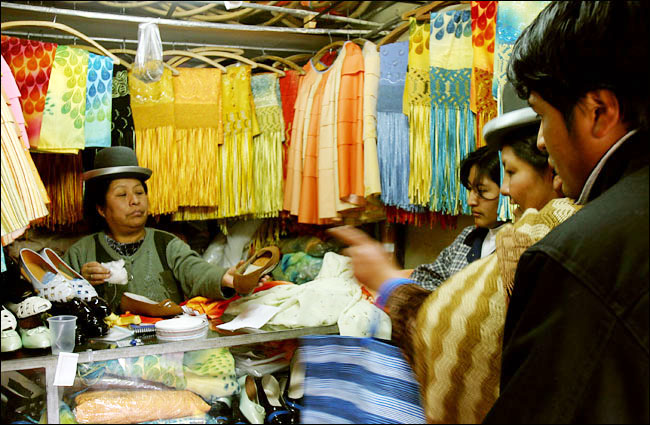 |
| Guadalupe Maidana de Yugra, who designs traditional clothing, selling shoes to a customer in her shop in La Paz. |
Even the Upscale Wear Indian Dress, but Not in the Office
 |
| Guadalupe Maidana de Yugra, who designs traditional clothing, selling shoes to a customer in her shop in La Paz. |
By JUAN FORERO
LA PAZ, Bolivia - Esther Rodríguez became the talk of La Paz
not long ago, when her delicate good looks and splendid attire, complete
with derby hat and layer-cake skirt, won her the city's beauty contest
for indigenous women.
Her coronation as Miss Cholita Paceña - a reference to the Cholas, or Indian women, of La Paz - was celebrated in all the daily papers. But soon after, the same papers "unmasked" Ms. Rodríguez by revealing that she never wore her pollera (pronounced pol-YEH-rah), the traditional flowing skirt worn by indigenous women, in her university classes.
"No one is obligated to dress in one particular way," Ms. Rodríguez, 23, said, putting up a spirited defense.
The episode spoke of a little-noticed but significant trend in Latin America's most indigenous country: a new generation of indigenous women, urban and professionally ascendant, who honor the customs of the past but embrace modern Bolivia, Western dress and all.
"My mother wears a pollera; so does my grandmother," explained Ms. Rodríguez, dressed for an interview in her winning green pollera at the food market where she works. "I don't wear it, only because I study here in the city."
The clothing worn by highland Indian women is a throwback to colonial times, when the Spaniards obligated the Indians to abandon their traditional dress and wear the garments then popular in Spain. The practice continued even after revolutionaries overthrew the monarchy in the early 19th century, evolving in accordance with the fashion style of the day.
Today many Indians see the adoption of old-fashioned skirts and hats as an act of empowerment that has only expanded as Bolivia's Indian culture has flexed its political muscle in recent years.
"Because it's part of our culture we wear this," said María Eugenia Roque, who is in her 30's and often wears the pollera. "That's where we're from. That's our story, our identity."
But even in this country, where perhaps 70 percent of its nine million people are of Indian descent, the future of the pollera and derby hat is far from certain.
No one is predicting the demise of the tradition. In fact, sales are as strong as ever, or stronger, thanks to the growing popularity of indigenous festivals and pollera competitions. But with indigenous women increasingly living in cities and a growing number of young Indians attending universities and breaking into the professional ranks, the clothing of the past is often reserved for special ceremonies and parties.
"If a young woman wants another life, if she wants a law degree or to go to medical school, she cannot go dressed as a Chola," explained David Mendoza, director of the Tambo Kirkincho cultural museum in La Paz, which includes an exhibition on Indian dress. "If you're successful, most women just do not wear the pollera."
For some young indigenous women it is just a matter of style and fashion. "I would not dress like that," scoffed Alison Cruz, 17, who works in her father's shop, Princess Hats, which sells the traditional derbies. "I would maybe do it to see what it looks like in the mirror. But I would never go out that way. I would not want people to see me like that. I like the way I look now."
Cost is also an issue. If a Chola really wants to dress to impress, the price can be prohibitive.
A top-of-the-line hat can cost $200, more than most Bolivians earn in a month. And a trendy pollera can go for as much as $50. All Cholitas also know that the attire must be accompanied by the most elaborate of gold jewelry, adding yet more expense.
"It's like wearing an Armani suit," said Patricia Yujra, a shopkeeper who sells all manner of polleras. "You have to have jewels that are the most beautiful, make sure that everything is just right. It's very important."
The hats are probably the most intricate, and certainly the most notable, accessories. Made of wool with leather trim by indigenous craftsmen, they are so valuable that women wrap them in plastic bags to protect against rain.
"The Cholitas want the pollera, the shoes, the hair done just right," explained Julio Cruz, the owner of Princess Hats. "They want to be just like a princess. They want to be beautiful."
Still, while business has been good, he knows that it may not last forever, as his daughter would be the first to tell him. Indeed, talk to any middle-aged Chola and her daughter and you are bound to find a generational split.
"We are the ones who dress like this," said Juana Pérez, 55, who looked impeccable on a recent day in her black bowler, fine black shawl, white shoes and burgundy pollera. Her six daughters, she said, would wear the pollera only in fiestas.
"The girls, they just do not want to wear it now," she said. "And their children? I don't think they will wear them either."
But Ms. Rodríguez, the reigning Miss Cholita Paceña, says the women of her generation mean no disrespect. At parties and festivals, she said, she will gladly wear her pollera and derby.
Times have changed, though, and a good pair of jeans and sweater are her favored options when attending classes or tromping across the steep streets of La Paz.
"Some people do not want to leave it all behind," Ms. Rodríguez said. "But if you go to my university you won't find any girls dressed in polleras."